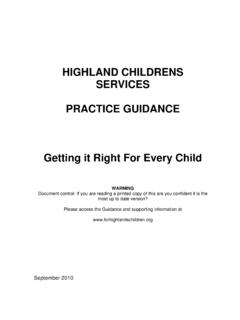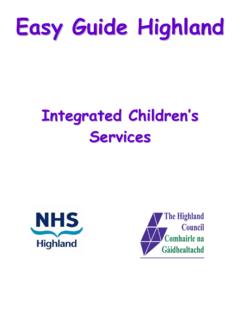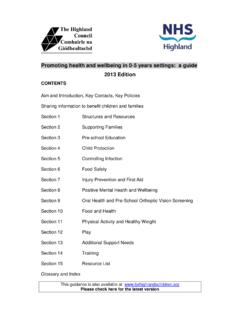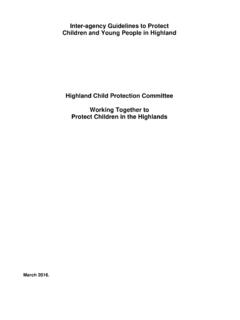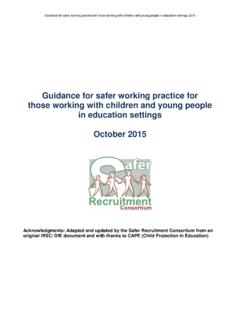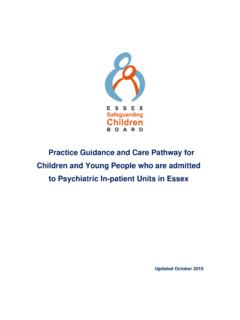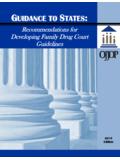Transcription of HIGHLAND CHILDRENS SERVICES HIGHLAND …
1 !1. HIGHLAND CHILDRENS . SERVICES . HIGHLAND PRACTICE MODEL. guidance . ( getting it Right For Every Child). WARNING. Document control - If you are reading a printed copy of this are you confident it is the most up to date version? Please access the guidance and supporting information at CONTENTS. Introduction Section 1 Definitions 2017. !2. Section 2 The HIGHLAND Practice Model Section 3 Integrated Delivery of SERVICES for Children Section 4 Key Roles and Responsibilities Section 5 Information Sharing Section 6 Identifying and responding to concerns Section 7 Child and Family Centred Practice Section 8 The Child's Plan Section 9 Additional information, guidance , notes, tools Appendices i Using the My World Triangle ii Using the Resilience Matrix iii ECS Form 1. Universal Child's Plan NHS - Community Midwifery Record iv Standard child concern form V Criteria for a good quality Child's Plan Vi Criteria for a Child's Plan going to Reporter Introduction The commentary in this guide for working within the HIGHLAND Practice Model will be amended and updated as required.
2 Reference should be made therefore to http://. for the most recent version of this document. This version will be further reviewed and updated following publication of statutory guidance anticipated in summer/autumn 2017 to support implementation of the Children and Young People (Scotland) Act 2014. 2017. !3. getting it right for every child: Integrated Children's SERVICES What is getting it right for every child? It is a consistent way for people to work with all children and young people. It is the bedrock for all children's SERVICES and should also be used by practitioners in adult SERVICES who work with parents or carers. The approach helps practitioners to focus on what makes a positive difference for children and young people and how they can act to deliver these improvements. getting it right for every child is reflected in policy, strategy, practice and legislation affecting children, young people and their families.
3 As children and young people progress through life, some may have temporary difficulties, some may live with challenges and some may experience more complex issues. Sometimes they and their families need help and support. No matter where they live or whatever their needs, children, young people and their families should always know where they can find help, what support might be available and whether that help is right for them. The getting it right for every child approach ensures that anyone providing that support puts the child or young person and their family at the centre. getting it right for every child is important for everyone who works with children and young people . as well as many people who work with adults who look after children. Practitioners need to work together to support families and, when appropriate, take early action at the first signs of any concern about wellbeing rather than only getting involved when a situation has already reached crisis point.
4 This means working across organisational boundaries and putting children and their families at the heart of decision making and giving all our children and young people the best possible start in life. ( background). Core Components The HIGHLAND Practice Model, based on getting it right for every child, is founded on 10 core components. 1. A focus on improving outcomes for children, young people and their families based on a shared understanding of well-being 2. A common approach to gaining consent and to sharing information where appropriate 2017. !4. 3. An integral role for children, young people and families in assessment, planning and intervention 4. A co-ordinated and unified approach to identifying concerns, assessing needs and agreeing actions and outcomes, based on the Well-being Indicators 5. Streamlined planning, assessment and decision-making processes that lead to the right help at the right time 6.
5 Consistent high standards of co-operation, joint working and communication when more than one agency needs to be involved, locally and across Scotland 7. A Lead Professional to co-ordinate and monitor such planned support for a child. 8. Maximise the skilled workforce within universal SERVICES to address needs and risks at the earliest possible time 9. A confident and competent workforce across all SERVICES for children, young people and their families 10. The capacity to securely share demographic, assessment and planning information within and across service and agency boundaries, using electronic systems when possible. Values and Principles The HIGHLAND Practice Model is underpinned by common values and principles which apply across all aspects of work with children and young people. Developed from knowledge, research and experience, they reflect the rights of children expressed in the United Nations Convention on the rights of the Child (1989) and build on the Scottish Children's Charter (2004).
6 They are reflected in legislation, standards, procedures and professional activity. Promoting the well-being of individual children and young people: this is based on understanding how children and young people develop in their families and communities and addressing their needs at the earliest possible time Keeping children and young people safe: emotional and physical safety is fundamental and is wider than child protection Putting the child at the centre: children and young people should have their views listened to and they should be involved in decisions which affect them Taking a whole child approach: recognising that what is going on in one part of a child or young person's life can affect many other areas of his or her life 2017. !5. Building on strengths and promoting resilience: using a child's or young person's existing networks and support where possible Promoting opportunities and valuing diversity: children and young people should feel valued in all circumstances and practitioners should create opportunities to celebrate diversity Providing additional help which is appropriate, proportionate and timely: providing help as early as possible, considering short and long-term needs Working in partnership with families: supporting wherever possible those who know the child or young person well, know what they need, what works well for them and what may not be helpful Supporting informed choice: supporting children, young people and families in understanding what help is possible and what their choices are Respecting confidentiality and sharing information.
7 Seeking agreement to share information that is relevant and proportionate while safeguarding children and young people's right to confidentiality Promoting the same values across all working relationships: recognising that respect, patience, honesty, reliability, resilience and integrity are qualities valued by children, young people, their families and colleagues Making the most of each worker's expertise: respecting the contribution of others and co-operating with them, recognising that sharing responsibility does not mean acting beyond a worker's competence or role. Co-ordinating help: recognising that children, young people and their families need practitioners and managers to work together, when appropriate, to promote the best possible help Building a competent workforce to promote children and young people's wellbeing: commitment to learning and development and improvement of inter- professional practice DEFINITIONS.
8 Wellbeing Children's wellbeing is at the heart of getting it right for every child. To achieve our aspirations for all HIGHLAND 's children to develop into confident individuals, effective contributors, successful learners and responsible citizens, every child and young person needs to be: 2017. !6. Safe Healthy Achieving Nurtured Active Respected & Responsible Included Assessment of wellbeing is supported by legislation (Children & Young People (Scotland) Act 2014). All SERVICES available to children and their families have the objective of contributing to positive wellbeing. Child The term child' in Scotland often means those below the age of 16 although the general definition in the Children (Scotland) Act 1995, the Protection of Children (Scotland) Act 2003 and the Children and Young Persons (Scotland) Act 2014 is a person below the age of 18.
9 HIGHLAND guidance applies to: unborn babies all children below the age of 16. those who are looked after children' up to the age of 18. young people aged 16 or 17 who are particularly vulnerable, for example as a result of disability young people, aged 16, 17 or 18 years, still enrolled in school 16 and 17 year olds who do not attend school but who wish to access contact with a Named Person up to age 18. The terms child' and young person' are used interchangeably throughout the guidance . Parents and Relevant Persons A parent is defined as someone who is the birth or adoptive mother or father of the child. A mother has automatic parental rights and responsibilities. A father has parental responsibilities and rights if he is or was married to the mother (at the time of the child's conception or subsequently) or if the birth of the child is registered after 4 May 2006 and he is recorded as the father on the child's birth certificate.
10 A father may acquire parental responsibilities and rights (PRR) under the Children (Scotland) Act 1995 by entering into a formal agreement with the mother, or by making an application to the courts and being granted PRR. Parental rights and responsibilities of a mother or a father can only be removed by a court order. 2017. !7. A Relevant Person within the Children's Hearing system is defined as any parent, any person who has parental responsibilities and rights in relation to a child, and any person who has been deemed to be a Relevant Person by a Children's Hearing or a Pre-hearing Panel because they have (or recently had) a significant involvement in the upbringing of the child. This last category may include for example a step parent or other carer. Universal SERVICES These are the health and education SERVICES to which all children and young people have access throughout their childhood.
